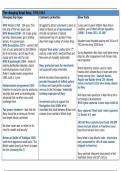The changing Royal Navy, 1763-1914
Changing ship types Commerce protection Slave Trade
HMS Victory 1765 – 104 guns, first Struggled to attract volunteers to navy so 2 ships sent to patrol 5000km West African
rate ship of the line, wood, sails relied on liberal use of impressment coastline, part of West African Squadron
HMS Nemesis1840 – fist ocean going (forcible recruitment of sailors) (1808) – 6 ships 1821, 32 1847
warship, steam power, go in shallow Impressment less of a burden if navy
waters, 4 six pound guns drew from large number of civilian ships Squadron least desirable posting with 204 out of
HMS Devastation 1873 – carried 1350 792 seamen dying 1829 alone
tons of coal, protected by 250-300mm Adopted ‘blue water’ policy from 17th
thick hull armour, end of age of sail, century, under which merchant fleet and During Napoleonic Wars Navy could seize enemy
supply ports now vital for coal Navy seen as mutually sustainable ships but after engagements with foreign ships
HMS Dreadnought 1906 – made all were regulated
existing battleships obsolete, steam Navy protected seas for merchants
turbine propulsion, result of John and captured foreign merchants British diplomatic position used to create
treaties which allowed Navy to board and seize
Fisher’s modernisation programme
foreign slaving ships – Spanish slavers,
1905, built in 1 year British merchant ships expected to
Regulo and Rapido threw 150 chained
provide thousands of skilled sailors
slaves overboard 1831 when being chased
Modernisation programme 1905 – to Navy and trade profits increased by Navy
intention to end arms race by producing revenue to the Exchequer, indirectly
warships that were so technologically funding expansion of Navy Anti-slave trade operations in West Africa led to
advanced that no other navy could technological developments:
challenge them Government policy to support this – HMS Hydra captured 4 slave ships 1844-46
Navigation Acts 1660s which
Two power standard – idea that the mandated that trade between Britain and Navy captured ‘Black Joke’ which captured
Navy should be as strong as the next colonies to be carried in British ships 11 slavers in 1 year
two largest navies combined
1810-60 Navy captured and freed 150,000
No other nation was so reliant on its slaves and put ashore in Freetown (naval
navy for wealth and security base which became Sierra Leon)
Nelson at Battle of Trafalgar 1805 Navy failed to stop Atlantic trade - freed slave
used more aggressive naval tactic. The only accounted for 10% of total number
British sailed directly at French to break shipped to Americas
the line (crossing the T)
Navy operated infrequent slave patrols in Red
Sea/Indian Ocean until 20th century
, The changing Royal Navy, 1763-1914
Suppressing piracy Attack on Algiers 1816 Exploration and Mapping
Robert Surcouf (1789-1808) – Most significant example of Navy Captain Cooks exploration of South Seas
successful French pirate who regularly defending British interests 1763-1890 1768-71
attacked British and traded illegally in Primary objective to improve oceanic
enslaved Africans Since 17th century Navy strong enough to navigation
intimidate Barbary States into leaving Joined by Joseph Banks who
Ching Shih (1807-1810) – most British shipping alone collected/documented over 1000 animal
successful pirate, 1808 Chinese gov species, 3600 plant species, 1400 of these
tried to destroy her but remained Royal Navy had sourced supplies from were unknown to science
undefeated Barbary States during wars with France No men died of scurvy, ensured
but by 1815 was able to resupply from cleanliness and ventilation in crews
Threat of French privateers only Europe quarters and insisted on diet including
eliminated when British gathered orange extract, cress, sauerkraut
sufficient forces to capture Isle de Lord Exmouth secured treaties with Beys As a result Navy began to distribute limes
France in 1810, which then became of Tunis, Tripoli, Algiers to sailors for Vitamin C
naval base
Bombardment of Algiers 1816 not Second voyage 1771-75
Arab pirates threatened shipping from effective as barbary States heavily Became first European ship to cross
the Red Sea. reliant on piracy for wealth Antarctic circle
Navy surveyors chartered Red Sea
1800-09 Britain bombarded Algiers again Third voyage 1776-79
Treaties signed with sultan of Aden 1820 and piracy wasn’t eliminated Aimed to find Northwest Passage, a
1802 for protection of British until French conquered Algiers 1830 hypothetical trade route linking Atlantic
commerce and Mocha bombarded and Pacific Oceans – noted freezing
1820 until the Imam accepted a Showed British willing to use force of conditions all year preventing any trade
commercial treaty Navy to protect foreigners under route
British protection Named Hawaiian Islands the Sandwich
Fleet of 100 pirate ships operated Islands
in Straits of Malacca from bases in Navy assumed role of worlds police
Philippines and Southeast Asia and force until 1914, period of Pax Cook created accurate maps of Pacific
were able to capture large European Britannica (cartographer) from first (1768-71) and
merchantmen second (1772-75) journeys using John
Harrison’s chronometer 1759
As opium sales to China increased




